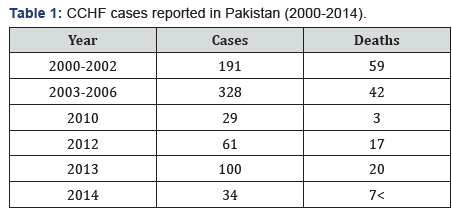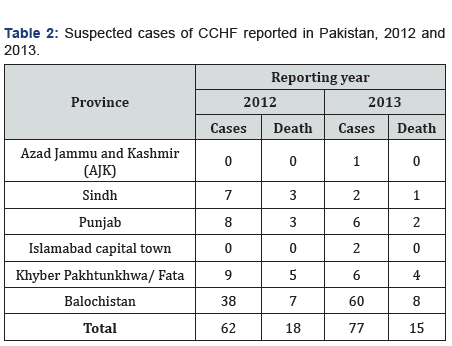Prevalence of Crimean-Congo hemorrhagic fever Virus in Pakistan-Juniper Publishers
JUNIPER PUBLISHERS-OPEN ACCESS JOURNAL OF DRUG DESIGNING & DEVELOPMENT
Crimean Congo virus that causes hemorrhagic fever belongs to Bunyaviridea family [1] and genus Nairoviridea [2]. First case of this disease was inspected in Tajisktan in 12th century [3] however this disease gained more attention in 1944 when about 200 military officers of Soviet Union died of this infectious disease at the place of Crimea so named as Crimean Congo hemorrhagic fever. Its etiology was studied by inducing fever in psychiatric patients by inoculating them with virus obtained from the blood of CCHF patients. Chumkov and his colleagues first time isolated a prototype of this virus in 1967 in Moscow [4]. This virus has wide geographical distribution and found across middle east, china, southern Europe, Africa and various areas of Asia [2]. CCHFV is a tripatric RNA virus (Three negative RNA strands that codes for three different proteins): S segment codes for nucleoprotein [5], M Segment for glycoprotein [6] and L segment for RNA dependent RNA polymerase [7]. These segments codes component for viral replication [8]. Virus attaches to host cell surfaces through glycol- proteins and enter in cell through endocytosis and further process takes place in cytoplasm. Negative RNA strand first transcribed to positive RNA and then translation occurs. Complete assembly and processing occurs in golgi apparatus intra cellulary and subsequently virion bud off through exocytosis. CCHFV is an arthropod or tick born virus, for which major hosts are livestock animals. Ticks of Haylomma family are known to be involved in the transmission of this disease to humans which are mainly found on hairy animals like sheep, cattle, and goat [9]. Hence this virus found on animals but do not show the symptoms of the disease [10]. Afterwards, the virus is transmitted to human via contact with infected animals. Moreover contact with body fluid of the infected individuals can also cause disease (nosocomial infection).
Incubation of period of the virus varies from 1 to 7 days with maximum 9 days and also depends on the rout of infection. When the virus is transferred through blood contact, the incubation period becomes 5 to 6 days, while on average incubation period for this virus is from 3 to 7 days. The disease symptoms are vomiting, nauseas. Muscular pain, headache, abdominal pain and high fever [11] Ribavirn is the only FDA approved drug that can be used to treat CCHF [12]. Preventive measures like gloves usage and other safety equipment can be used while contacting livestock animals. Since it can be transmitted by contact with body fluids of infected persons hence person dealing with infected individual should also adopt precautionary measures.
CCHFV has wide geographic distribution including endemic to certain areas including Pakistan. In various regions of Pakistan, CCHFV fever patients were inspected. In 1960’s CCHFV strain was isolated in Chaanga Maanga forest in Lahore, while first case of CCHFV fever was reported in Rawalpindi in 1976 at General Hospital. A patient suffered from abdominal pain and fever was admitted to it and later diagnosed with CCHFV. In 1994, a case was reported in Quetta in which health workers were died by contacting CCHFV during surgery of a bleeding patient. Experiments were then conducted to inspect the ways of CCHFV transmission by contact with blood and other body fluids of infected people. In December 2005, a CCHFV victim was inspected in combined military hospital of Abbott a bad city located in north of Hazara division, Pakistan. This was a thirty two years old male who suffered from fever and abdominal pain, had five days history of fever and later was diagnosed with CCHFV. In 2000, CCHFV was revealed in Peshawar, the identified patient suffered from sore throat, chills. The patient’s father was died with the same disease two weeks ago. In 2002, a 25 years old woman was diagnosed with CCHFV fever in Kashmir. According to WHO report [13], from January 1 to 9 June 2013 almost twenty six CCHFV cases were diagnosed with mortality rate of 37.5%, however sixty nine cases were identified in 2015-16 from different regions of Pakistan. Since 2011-2013, one hundred and eighty three cases were confirmed with 50% fatality rate. Survey reveals that among several regions about 62% cases are observed in area Killa Abdullah, Killa Saifullah, and Quetta with some incidences in Rawalpindi, Multan, Dera Isnail Khan, Chakwal, and Bannu. (Table 1) shows the suspected cases of CCHF in Pakistan from 2000-2014. A total of 77 suspected cases including 15 deaths (CFR:19.4%) were reported from the country between 1st January to 29 September 2013. Of these reported cases, 48 were laboratory confirmed. During the current year, CCHF cases have been reported from all the provinces of Pakistan, including from the capital city of Islamabad (Table 2). Investigations revealed that the majority of the cases had history of contact with animals and animal skins. So far no transmission has been reported in hospitals that may be associated with health care [14,15].


For more Open Access Journals in Juniper Publishers please click on: https://juniperpublishers.com
For more articles in Open Access Novel Approaches in Drug Designing & Development please click on: https://juniperpublishers.com/napdd/index.php
For more Open Access Journals please click on: https://juniperpublishers.com
To know more about Juniper Publishers please click on: https://juniperpublishers.business.site/




Comments
Post a Comment